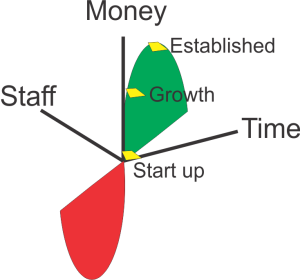Kate, our sales doyen, sniffed, “Sometimes I think clients are like unruly kids!”
Kate responded, “Jonathan, a client who has been in business forever and over the years volunteered to advise start-ups is going through a life change. He’s retiring from his old business and about to start a new one. He’s so fired up he is overlooking all the basics that need to be done before a launch.”
Rick, Mr. Direct Marketing, asked, “What kind of business is he starting?”
“Consulting,” Kate said. She went on, “He just doesn’t want to do the work he needs to do to increase his chances of success.”
“Could it be an age thing?” I asked. “I don’t mean his age although that is important for consultants but rather a company’s age. Is he thinking like an ‘old-timer” when he is actually a newbie in the new business?”
You’ve updated your Company Phase research again, haven’t you brer’ fox?” said Rob, the Georgia born branding expert.
Chris looked puzzled so Rob continued, “He’s been surveying successful B to B businesses for more years than you’ve been alive. As I recall there are three phases:
- Start up
- Growth
- Established
He’s figured out what marketing works in each phase and because he’s done so much work with consultants he can streamline recommendations and jus’ plain put a jack under your ROI.”
Kate jumped back in asking, “What should I tell Jonathan other than to come talk to you, Fletch?”
“He’s pretty definitely a start up from what you said, so maybe the thing to do is take him for a trip down memory lane. Every business starts the same way whether we want to remember it or not. The differences over time can be put into a 3D matrix. All that changes is Time, Money and Staff. In part, those variables control what you can do to market a firm. But they don’t really change what is effective.”
Chris asked, “So different things are more effective in each phase?”
“You got it. When anyone starts out, especially consultants, they have to get to Trust. There are three ways to get enough trust to get a contract:
- Sell a previous employer
- Sell someone referred by a previous employer
- Network to a previous contact familiar with your work and sell ‘em
Over time, every successful consulting organization, comes to rely on referrals.
Every successful organization.
The Takeaway:
Here are the key ways consultants get business in each phase in order of importance:
Start Up Growth Established
Direct Sales Referrals Referrals
Networking Direct sales Prior experience
Referral Networking Direct Sales
Prior experience Prior experience Direct Marketing
Direct Marketing Direct Marketing Everything Else
Everything else Everything else Networking
Jerry Fletcher’s blog recaps conversations with clients, prospects and the unruly mob of business development professionals he consorts with. They discuss marketing that works from solopreneur to enterprise level. Jerry Fletcher is the ringleader and “Watson” of the dialogue.
Jerry has been researching and implementing small business marketing that builds businesses, careers and lives of joy for 25 years as President of Z-axis Marketing, Inc. Learn more at www.JerryFletcher.com
Schedule a personal appearance. Jerry speaks internationally on Networking, Marketing and Contact Relationship Magic. www.NetworkingNinja.com



